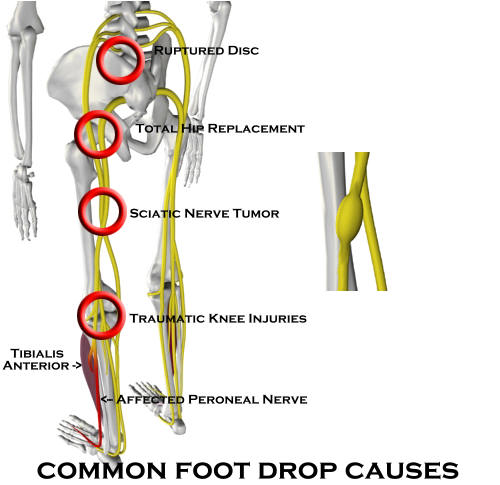
Foot Drop (Drop Foot)
Synopsis
Foot drop is a weakness of muscles that are involved in flexing the ankle and toes. As a result, the toes droop downward and impede the normal walking motion. The use of the term foot drop can make it seem as if the condition is rather simple and inconsequential. This is not the case. Foot drop can be a consequence of injury to muscles that are known as dorsiflexor muscles, injury to certain nerves, a stroke, brain injury, toxic effect of drugs, and even diabetes. Foot drop is likely not a new diagnosis. Historical descriptions that match foot drop date back over 2000 years.

Foot drop can also be described as drop foot, steppage gait, and as equinovarus deformity.
Foot drop affects both males and females. However, it is more common in males (the male to female ratio is approximately 2.8:1). Both feet are equally as prone to develop the problem. Some forms of foot drop occur in mid-aged people who put stress on that area of the body during athletics. Surgery to the knee or leg can lead to nerve damage that then leads to the development of foot drop. For example, approximately 0.3–4% of people who have a surgical procedure called a total knee arthroplasty develop foot drop. People who undergo surgery to the tibia (a leg bone) subsequently experience foot drop at a rate of 3–13%.
Foot drop is caused by weakness that occurs in specific muscles of the ankle and the foot. The affected muscles participate in the downward and upward movement of the ankle and the foot. The specific muscles include the anterior tibialis, extensor hallucis longus, and the extensor digitorum longus. The normal function of these muscles is to allow the toes to swing up from the ground during the beginning of a stride and to control the movement of the foot following the planting of the heel towards the end of the stride. Abnormal muscle function makes it difficult to prevent the toes from clearing the ground during the stride. Some people with foot drop walk with a very exaggerated swinging hip motion to help prevent the toes from catching on the ground. Another symptom of foot drop, which occurs as the foot is planted, is an uncontrolled slapping of the foot on the ground.
There are three general causes of the muscle weakness. Damage to nerves can affect the transmission of impulses that help control muscle movement and function. Motor neuron diseases such as amyotrophic lateral sclerosis (ALS) or post-polio syndrome, tumors in the brain or spinal cord, or diseases of the nerve roots of the lumbar spine are all neurological conditions that may produce foot drop. Second, the muscles themselves may be damaged. Third, there can be some skeletal or other anatomical abnormality that affects the movement of the ankle or foot. A combination of these factors can also be involved, as is the case with the drop foot diagnosis known as Charcot foot.
Diagnosis of foot drop is based on the visual appearance of the altered behavior of the foot. Analysis of blood can be done to look for a metabolic cause, such as diabetes, alcoholism, or presence of a toxin. Among the tests commonly performed are fasting blood sugar, hemoglobin determination, and determination of the levels of nitrogen and creatinine.
Visual examination of the foot can include routine photographs, magnetic resonance imaging (MRI) or magnetic resonance neurography (both of which are useful in visualizing areas surrounding damaged nerves). An electromyelogram can be useful in distinguishing between the different types of nerve damage that can be responsible for foot drop.
Treatment can involve the family physician, family members, and physical therapists. Physical therapists guide exercises that assist in maximizing muscular strength.
Foot drop that cannot be treated by surgery is often treated using a special orthotic device that provides normal range of motion to the foot and ankle during walking(an AFO brace). Other people with foot drop can benefit from the stimulation of the affected nerves. The stimulation is applied as the foot is raised during a stride and is stopped when the foot touches down on the ground.
When the cause of foot drop is a muscular or nerve difficulty, surgery can be beneficial. Surgery can relieve the pressure on a compacted nerve, repair a muscle, and even restore a normal gait by lengthening the Achilles tendon or replacing a defective tendon.
Depending on the nature of the cause of foot drop, recovery can be partial or complete. Physical therapy and an ankle foot orthotic device worn in the shoe are important aspects of rehabilitation..
When foot drop is due to a compressed nerve, corrective surgery can produce a complete recovery within several months. If the cause is a skeletal problem or other neurological problem, the prognosis for complete recovery is not as certain.